Instability of Embankment Slopes Due to Overflow and Drawdown
Abstract
:1. Introduction
2. Hydrological Analysis of Embankment Slope
2.1. Initial Water Levels of an Embankment Using Copula Functions
2.2. Overtopping Probability
3. Geotechnical Analysis of Embankment Slope
3.1. Stability Analysis of a Slope Due to Drawdown
3.2. Stability Analysis of a Slope Due to Drawdown and Tension Cracks
3.3. Stability Analysis of a Slope Due to Overtopping
4. Conclusions
- 1.
- The hydrological analyses revealed that utilizing copula functions to account for the water level fluctuations resulted in a higher probability of overtopping than a conventional approach that relied on the seasonal flood-limited water level. This proposed approach can be viewed as a proactive effort for enhancing the stability of the embankment slope in the face of climate change challenges.
- 2.
- During rapid drawdown, the upstream slope of the embankments presented the highest risk. However, an increased risk was identified in the downstream slope of the embankments during the initial stages of overflow, which could result in soil erosion and entrainment due to saturated conditions.
- 3.
- Countermeasures against tensile cracks, a critical factor triggering collapses during drawdown events, should be thoroughly examined. In addition, the approach involving the initial fluctuation of the water levels plays a crucial role in the potential for embankment overflow during extreme rainfall events.
Author Contributions
Funding
Institutional Review Board Statement
Informed Consent Statement
Data Availability Statement
Conflicts of Interest
References
- von Hardenberg, W. Expecting Disaster: The 1963 Landslide of the Vajont Dam. Arcadia 2011, 3. [Google Scholar]
- Kaktins, U.; Davis Todd, C.; Wojno, S.; Coleman, N. Revisiting the timing and events leading to and causing the Johnstown flood of 1889. Pa. Hist. 2013, 80, 335–363. [Google Scholar] [CrossRef]
- Dhar, O.N.; Rakhecha, P.R.; Mandal, B.N.; Sangam, R.B. The rainstorm which caused the Morvi dam disaster in August 1979/L’orage qui a provoqué la catastrophe du barrage Morvi août 1979. Hydrol. Sci. J. 1981, 26, 71–81. [Google Scholar] [CrossRef]
- Eash, D.A. Floods of July 23–26, 2010, in the Little Maquoketa River and Maquoketa River Basins. In Northeast Iowa: U.S. Geological Survey Open-File Report 2011–1301; 2012; p. 45. [Google Scholar]
- Chraibi, A.F.; Schleiss, A.J.; Tournier, J.P. Failure of Saddle Dam, Xe-Pian Xe-Namnoy Project: Executive Summary. In Dam Breach Modelling and Risk Disposal. ICED 2020; Zhang, J.M., Zhang, L., Wang, R., Eds.; Springer Series in Geomechanics and Geoengineering; Springer: Cham, Switzerland, 2020. [Google Scholar]
- Lou, W.C. Mathematical Modeling of Earth Dam Breaches. Unpublished. Ph.D. Dissertation, Colorado State University, Fort Collins, CO, USA, 1981. [Google Scholar]
- Middlebrooks, T.A. Earth-Dam Practice in the United States. Teans. Amer. Soc. Civil Eng. 1953, 118, 679–722. [Google Scholar] [CrossRef]
- Gruner, E. The Mechanism of Dam Failure. In Proceedings of the 9th Congress of the International Commission on Large Dams, Istanbul, Turkey, 4–8 September 1967; pp. 197–206. [Google Scholar]
- Takase, K. Statistic Study on Failure, Damage and Deterioration of Earth Dams in Japan. In Proceedings of the 9th Congress of the International Commission on Large Dams, Istanbul, Turkey, 4–8 September 1967; pp. 1–19. [Google Scholar]
- Babb, A.O.; Mermel, T.W. Catalog of Dam Disasters, Failures and Accidents; U.S. Bureau of Reclamation: Washington, DC, USA, 1968.
- Biswas, A.K.; Chatterjee, S. Dam Disasters—An Assessment. Eng. J. 1971, 54, 3–8. [Google Scholar]
- USCOLD. Lessons from Large Dams, Report of the Committee on Failures and Accidents to Large Dams of USCOLD; American Society of Civil Engineers: New York, NY, USA, 1975. [Google Scholar]
- Liu, D.; Lee, K.H. Flooding Simulation of Sandae Reservoir Collapse using 2D Hydrologic Model FLO-2D. J. Environ. Sci. Int. 2022, 31, 757–766. [Google Scholar]
- Lee, J.Y.; Park, D.H.; Kim, S.J.; Kim, T.W. Estimation of Break Outflow from the Goeyeon Reservoir Using DAMBRK Model. KSCE J. Civil. Environ. Eng. Res. 2017, 37, 459–466. [Google Scholar]
- Prendergast, J.D. Probabilistic Concept for Gravity Dam Analysis, Special Rep, M-265, Construction Engineering Research Lab; U.S. Army Corps of Engineers: Champaign, IL, USA, 1979.
- Dekay, M.L.; McClelland, G. Predicting loss of lifein cases of dam failure and flash flood. Risk Anal. 1993, 13, 2. [Google Scholar] [CrossRef]
- Kwon, H.H.; Moon, Y.I. Improvement of Overtopping Risk Evaluations Using Probabilistic Concepts for Existing Dams. Stoch. Environ. Res. Risk Assess. 2006, 20, 223–237. [Google Scholar] [CrossRef]
- Hsu, Y.C.; Tung, Y.K.; Kuo, J.T. Evaluation of dam overtopping probability induced by flood and wind. Stoch. Environ. Res. Risk Assess. 2011, 25, 35–49. [Google Scholar] [CrossRef]
- Kwon, H.H.; Moon, Y.I.; Khalil, A.F. Nonparametric monte carlo simulation for flood frequency curve derivaion: An application to a KOREAN watershed. J. Am. Water Resour. Assoc. 2007, 43, 1316–1328. [Google Scholar] [CrossRef]
- Sklar, M. Foncitions de Repartition a n Dimensions et Leurs Marges; Publications de Institut de Statistique Universite de Paris: Paris, France, 1959; Volume 8, pp. 229–231. [Google Scholar]
- Nelsen, R.B. An Introduction to Copula; Springer: New York, NY, USA, 2006; pp. 109–155. [Google Scholar]
- Na, B.K.; Kim, J.Y.; Lim, J.Y.; Kwon, H.H. Improvement of Hydtologic Dam Risk Analysis Model Considering Uncertainty of Hydrologic Analysis Process. J. Korea Water Resour. Assoc. 2014, 47, 853–865. [Google Scholar] [CrossRef]
- Sun, Y.; Li, Z.; Yang, K.; Wang, G.; Hu, R. Analysis of the Influence of Water Level Change on the Seepage Field and Stability of a Slope Based on a Numerical Simulation Method. Water 2023, 15, 216. [Google Scholar] [CrossRef]
- Liu, D.; Lin, T.; Gao, J.; Xue, B.; Yang, J.; Chen, C.; Zhang, W.; Sun, W. Study on the Influence of Water Level on Earth Dam Reinforced by Cut-Off Wall: A Case Study in Wujing Reservoir. Water 2023, 15, 140. [Google Scholar] [CrossRef]
- Xu, J.S.; Yang, X.L. Three-dimensional stability analysis of slope in unsaturated soils considering strength nonlinearity under water drawdown. Eng. Geol. 2018, 237, 102–115. [Google Scholar] [CrossRef]
- Ministry of Land, Infrastructure and Transport. Criteria and Description of River Design; Ministy of Land, Infrastructure and Transport: Seoul, Republic of Korea, 2009.
- GeoStudio, version 8.16.5. Manual for SEEP/W and SLOPE/W Modeling; GEO-SLOPE International, Ltd.: Calgary, AB, Canada, 2016.
- van Genuchten, M.T. A Closed Form Equation for Predicting the Hydraulic Conductivity of Unsaturated Soils. Soil Sci. Soc. Am. J. 1980, 44, 892–898. [Google Scholar] [CrossRef]
- Jeong, S.; Lee, K.; Kim, J.; Kim, Y. Analysis of rainfall-induced landslide on unsaturated soil slopes. Sustainability 2017, 9, 1280. [Google Scholar] [CrossRef]
- Kim, J.; Kim, Y.; Jeong, S.; Hong, M. Rainfall-induced landslides by deficit field matric suction in unsaturated soil slopes. Environ. Earth Sci. 2017, 76, 808. [Google Scholar] [CrossRef]


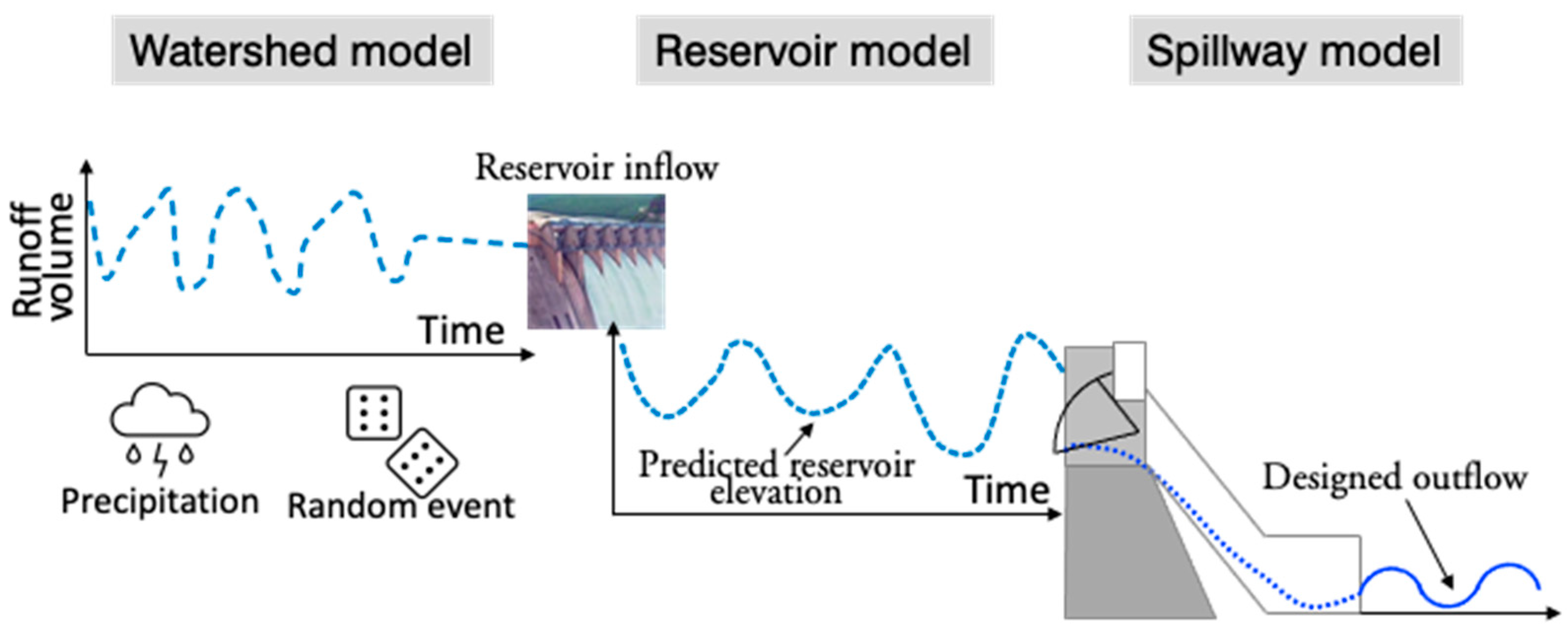
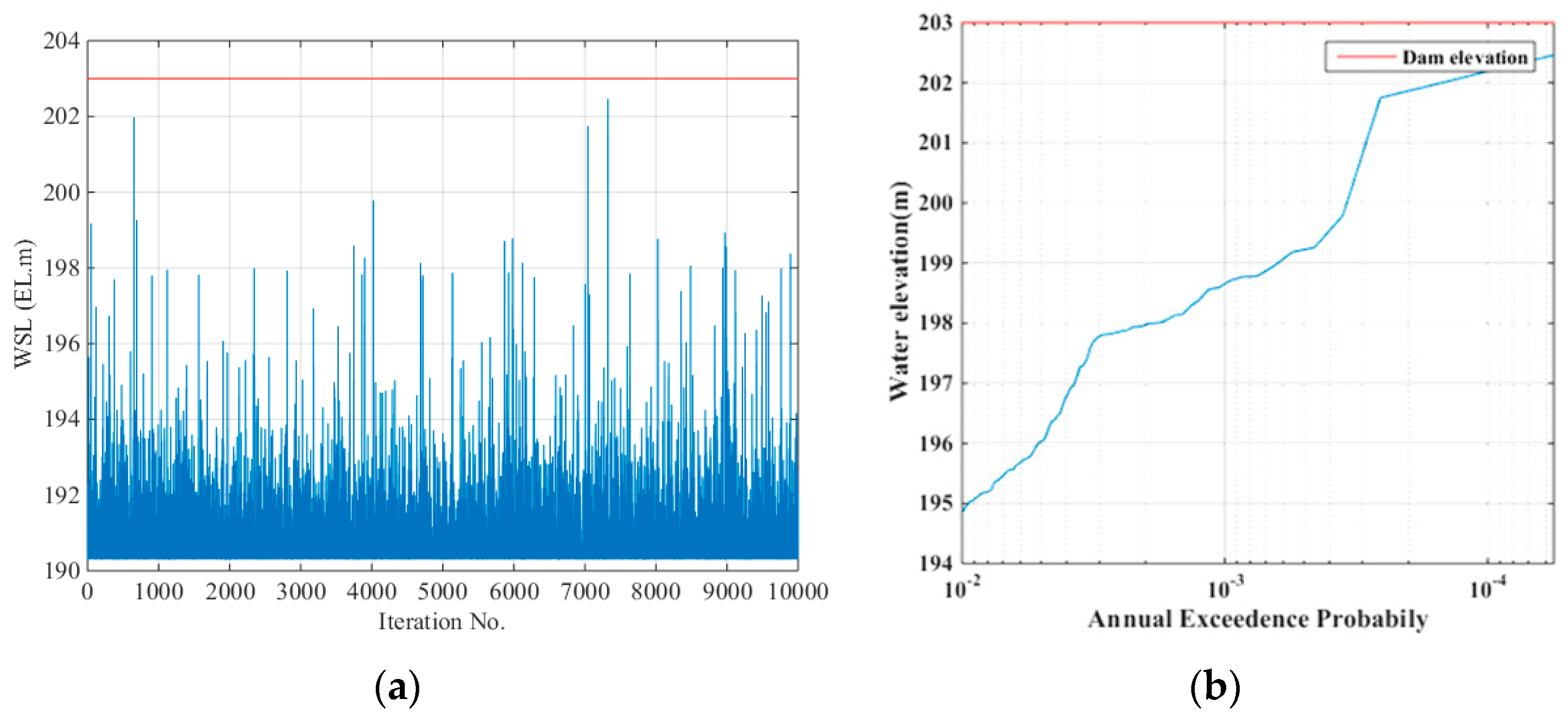
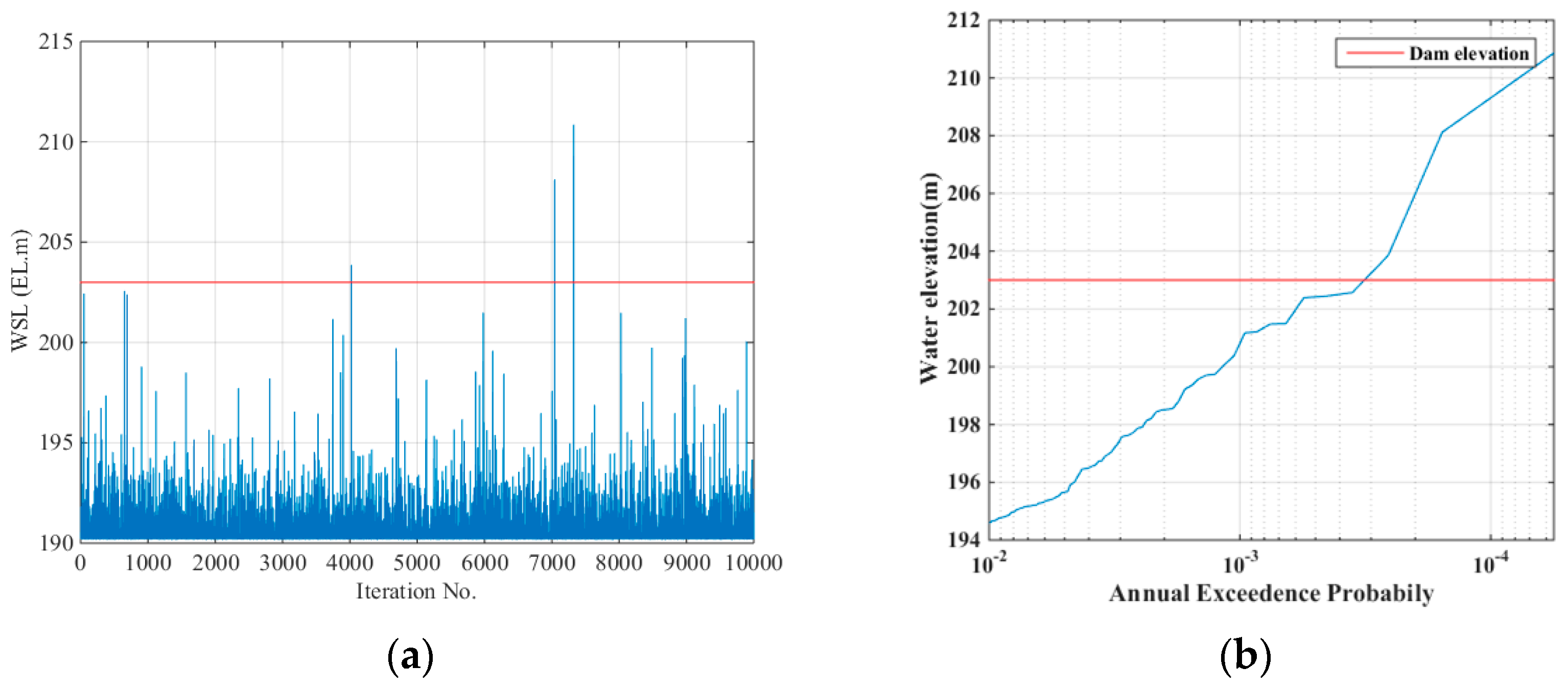

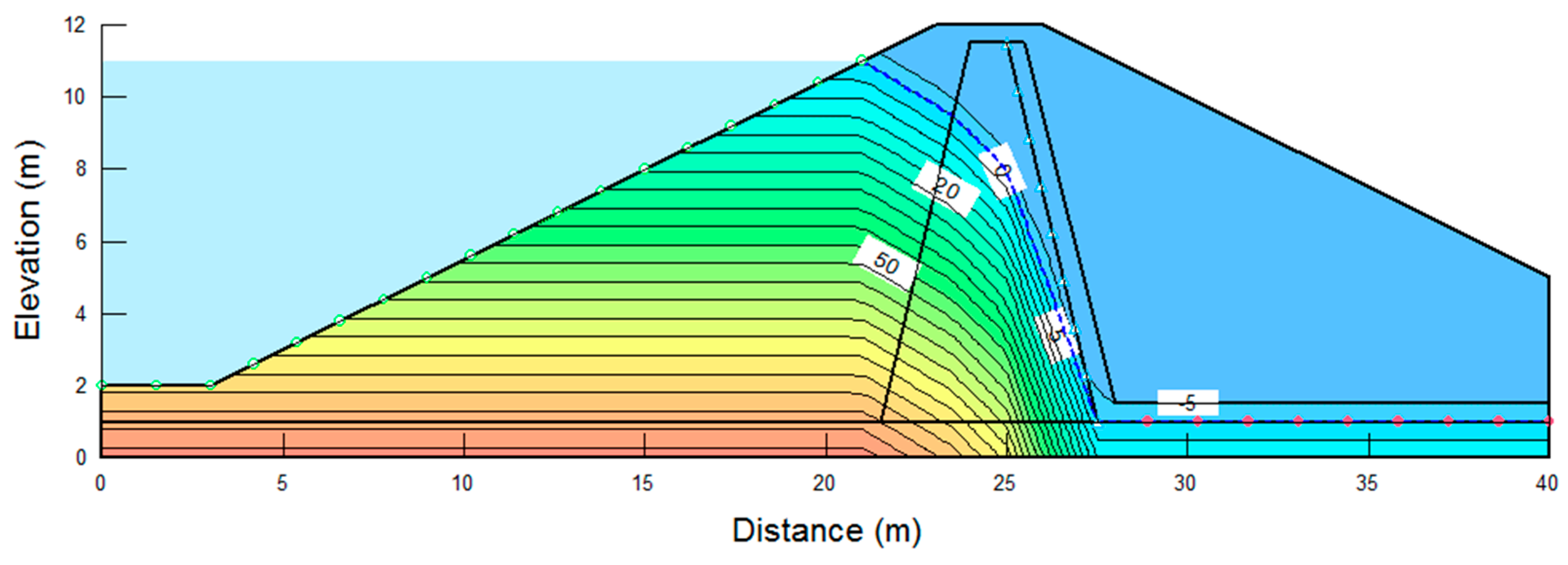
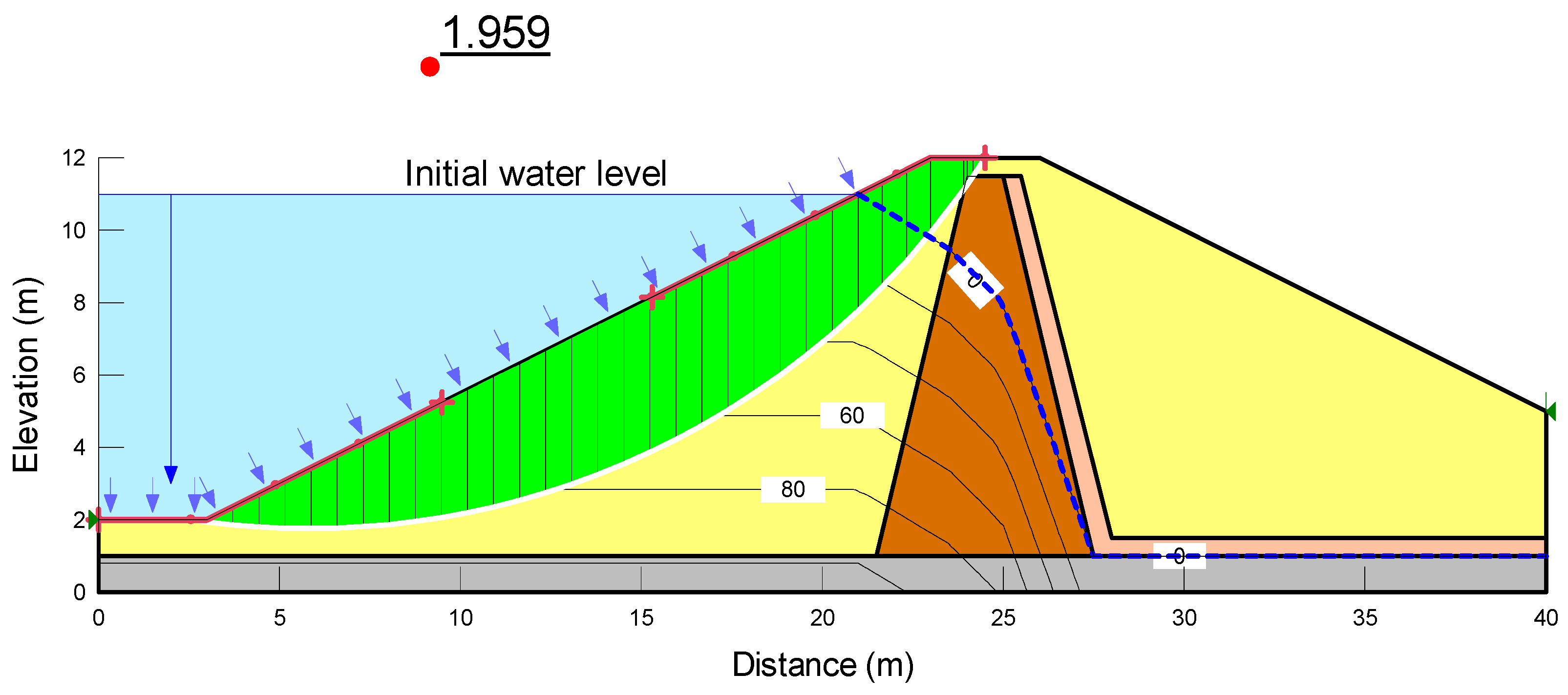
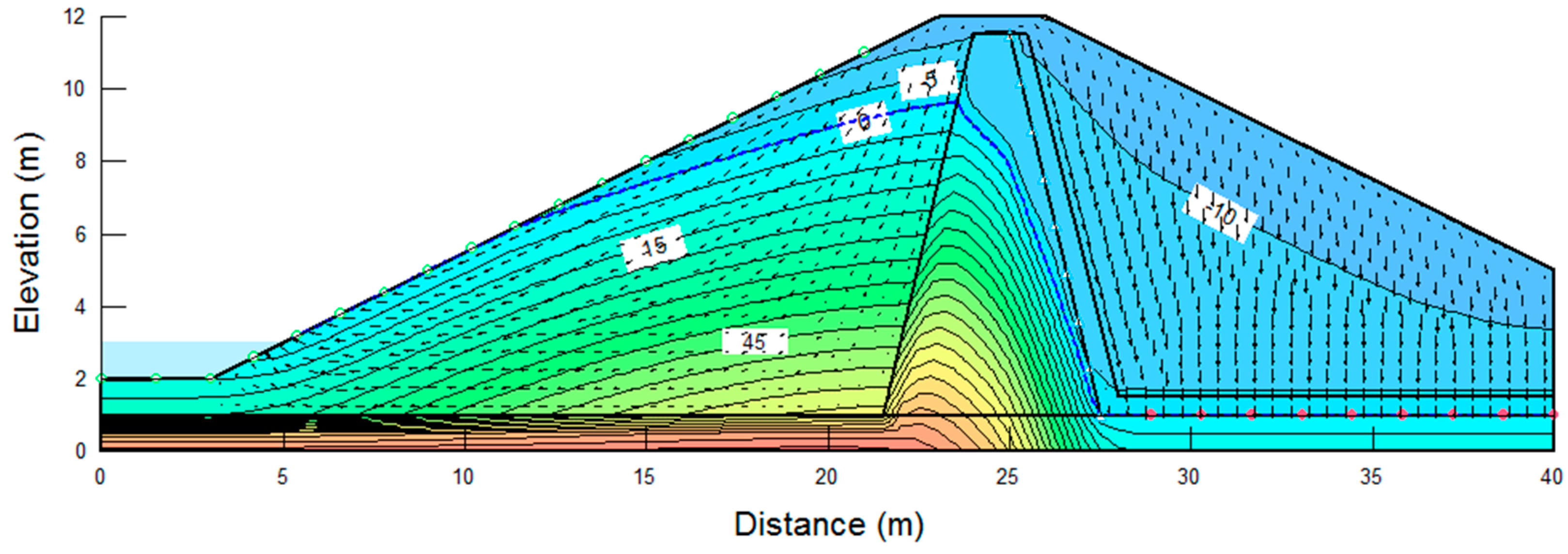
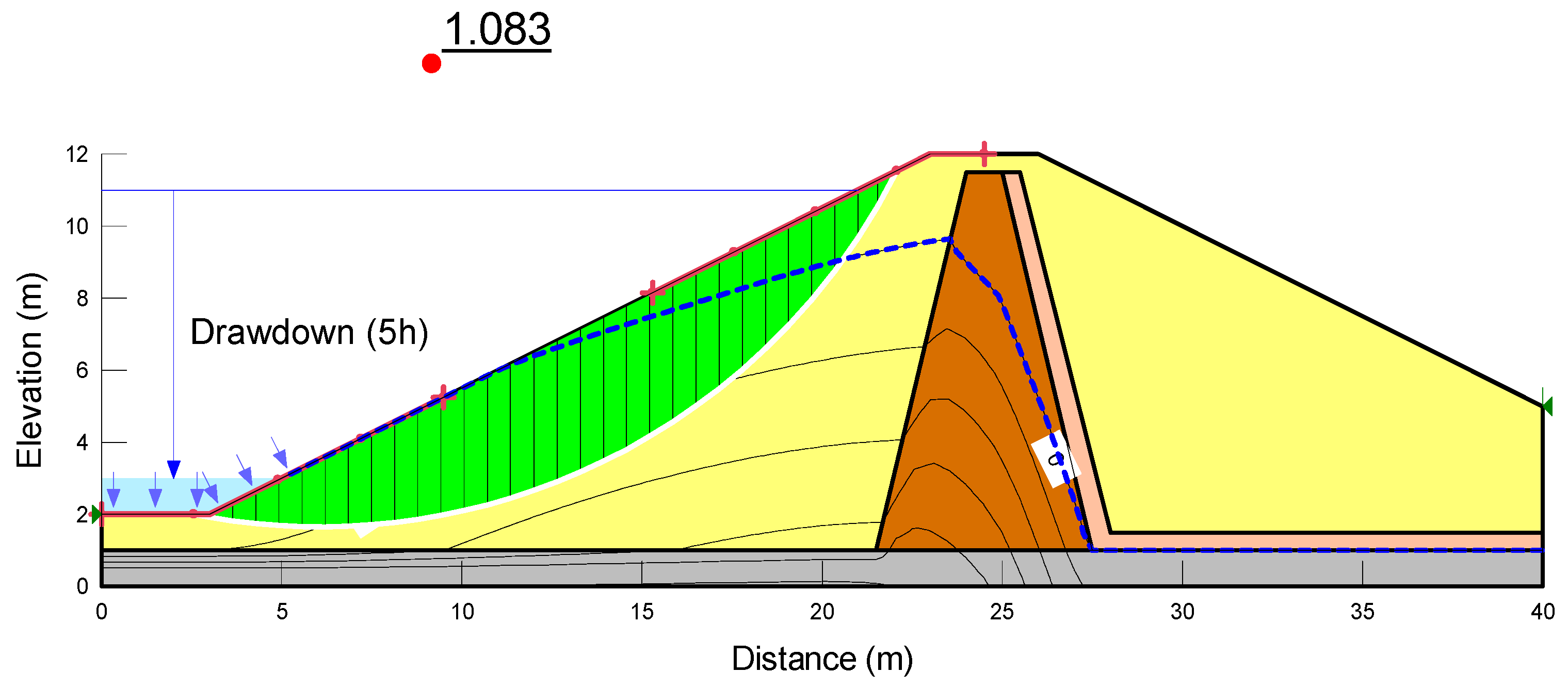
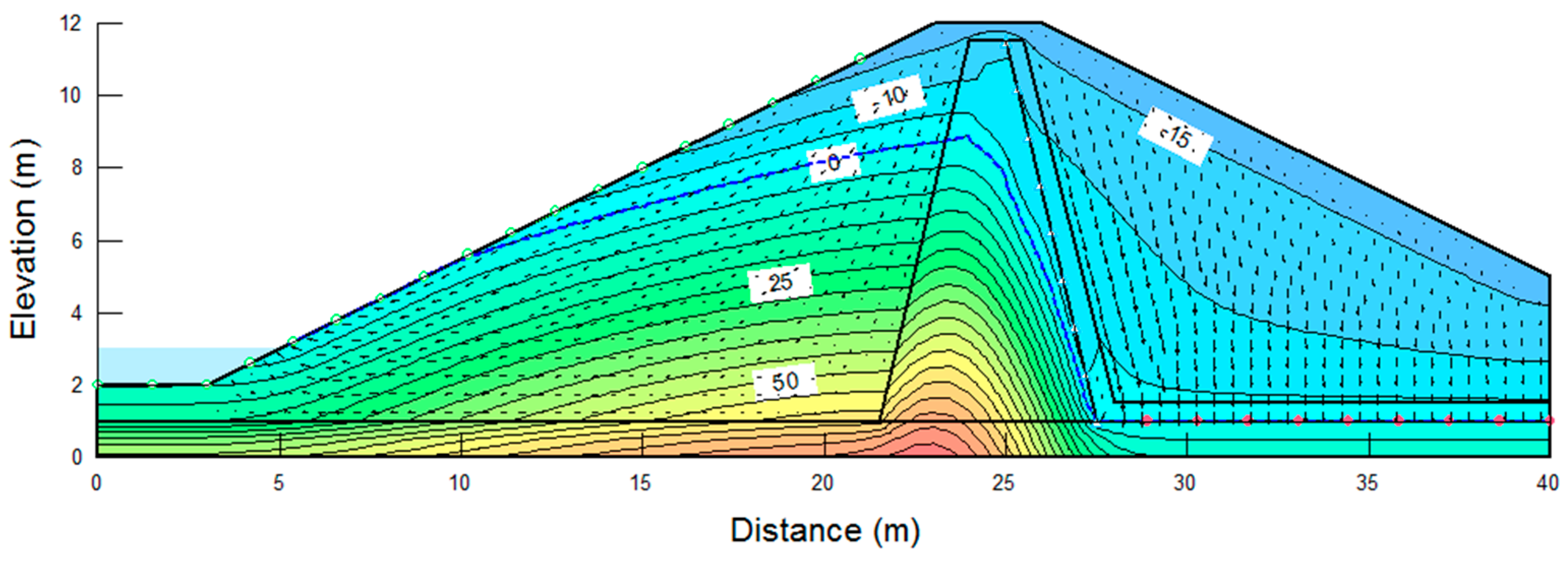
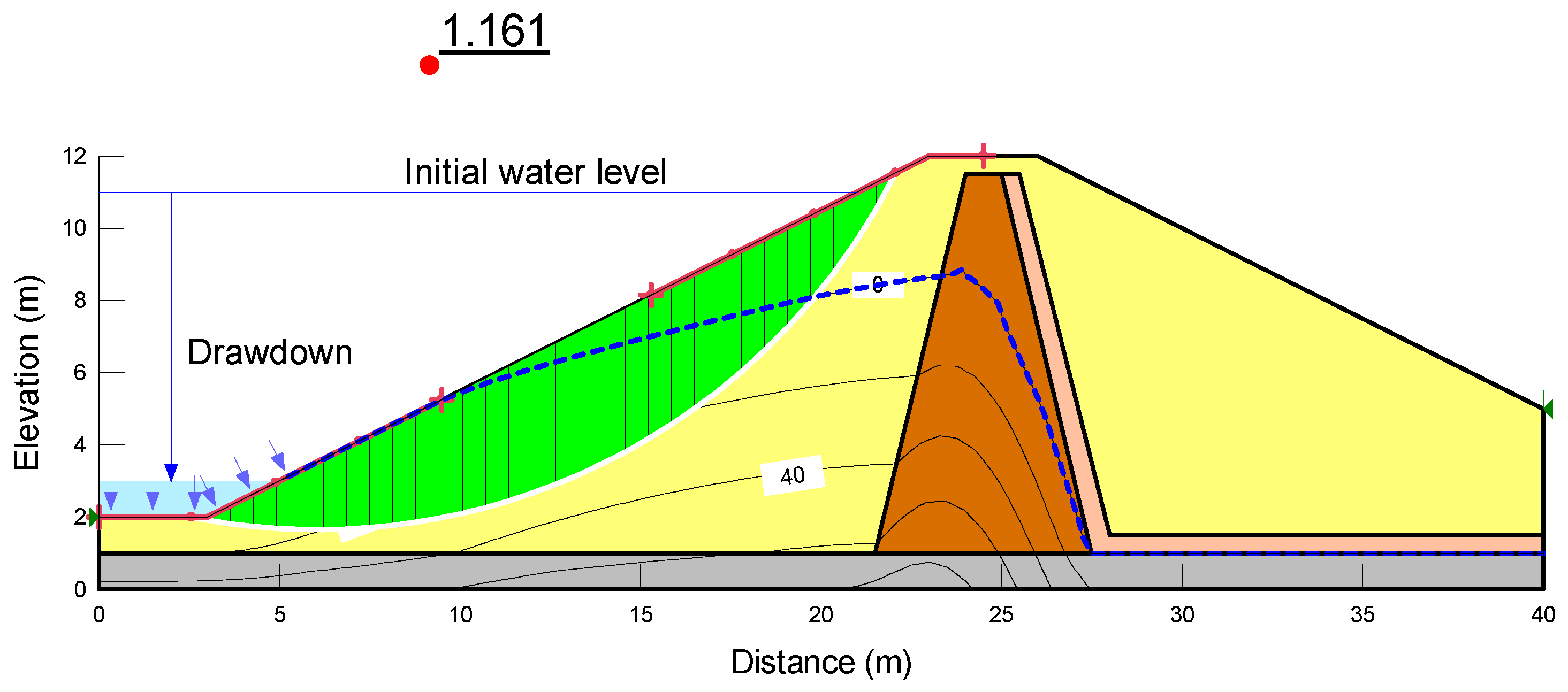
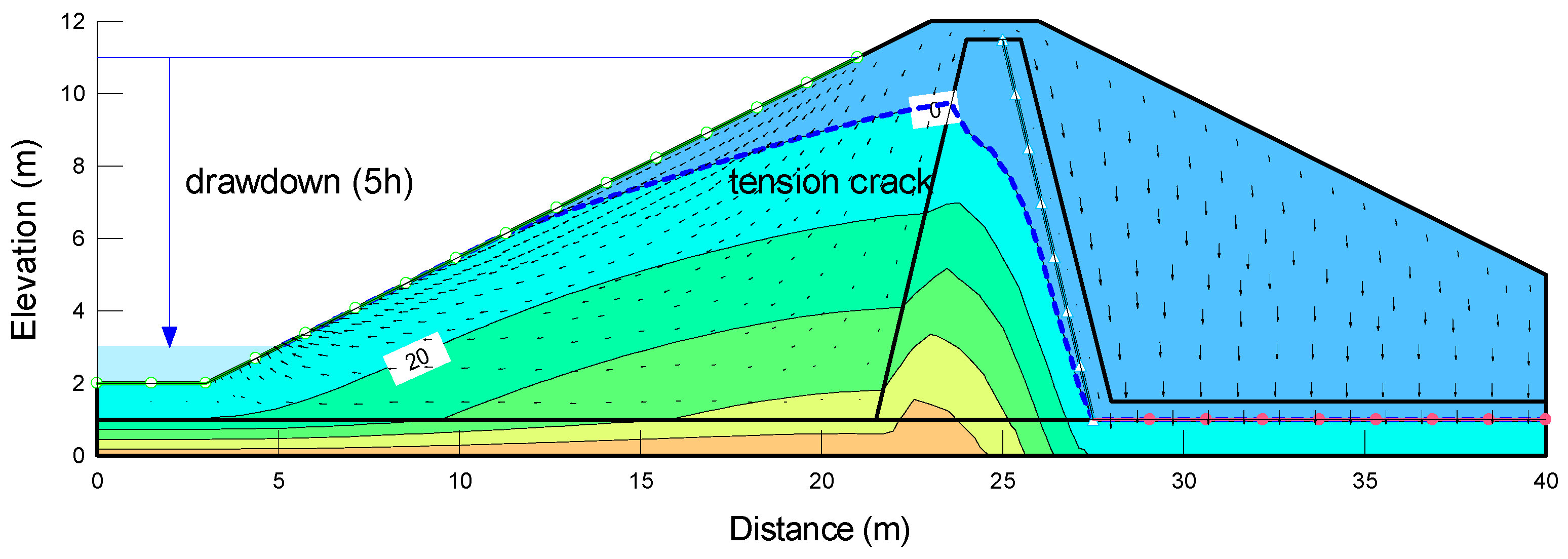

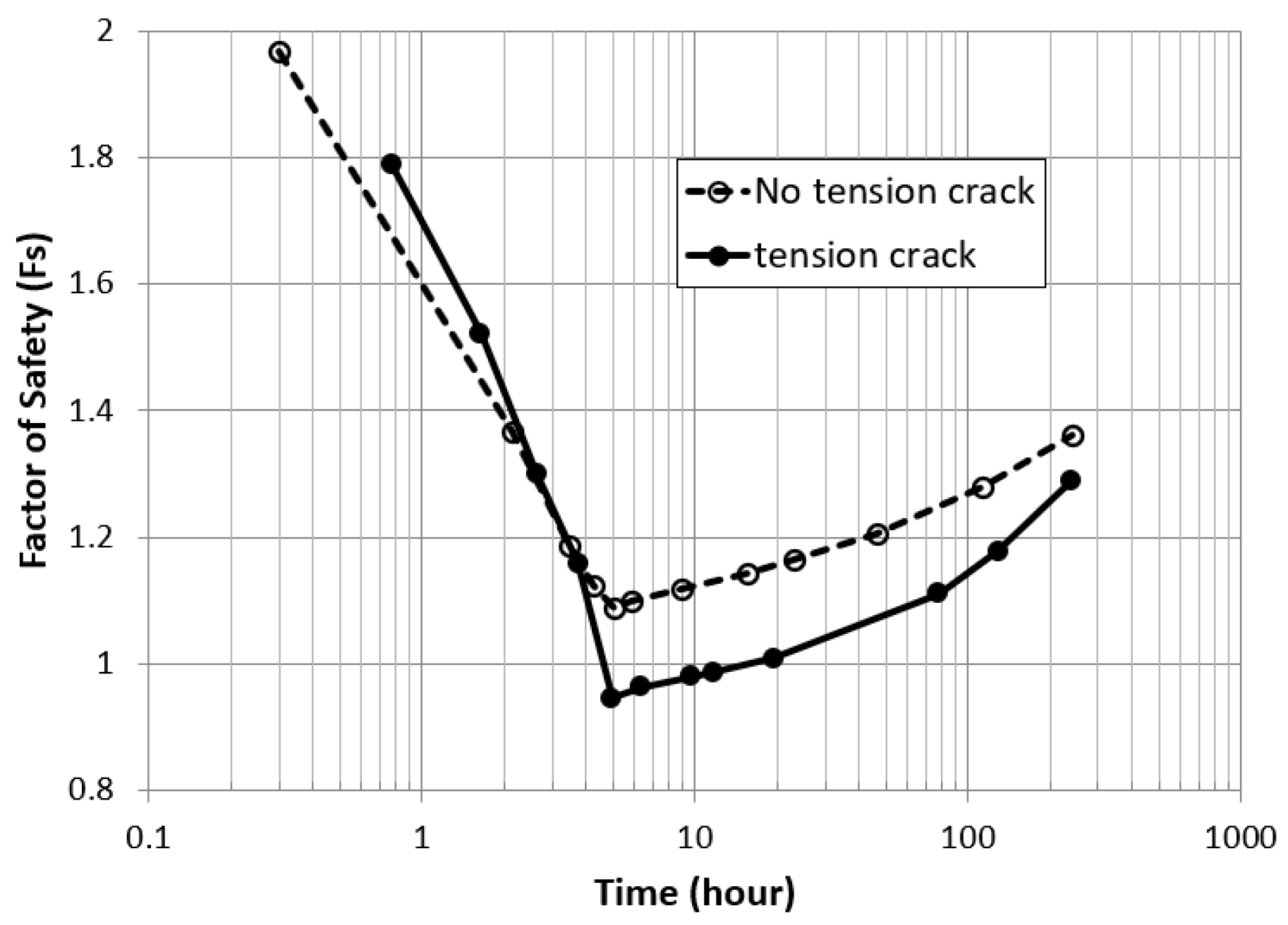

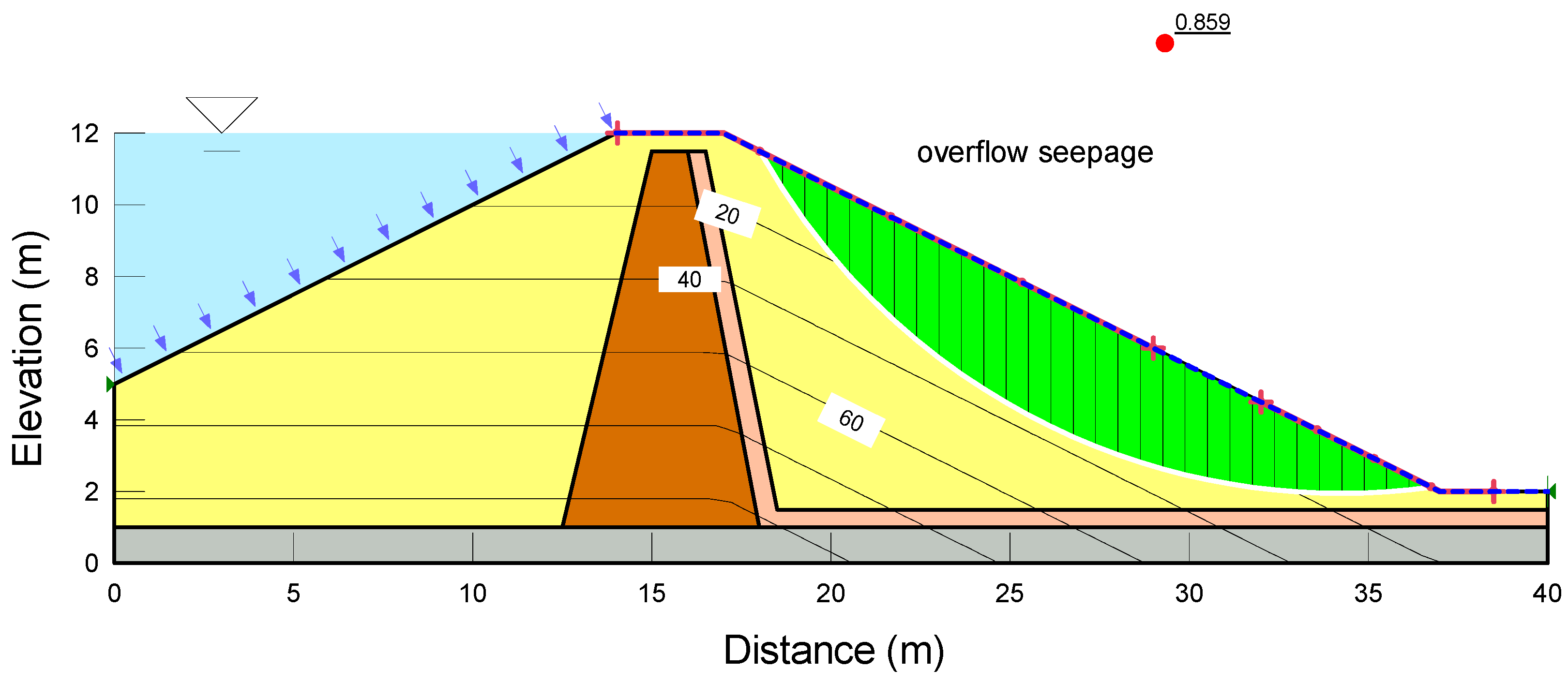
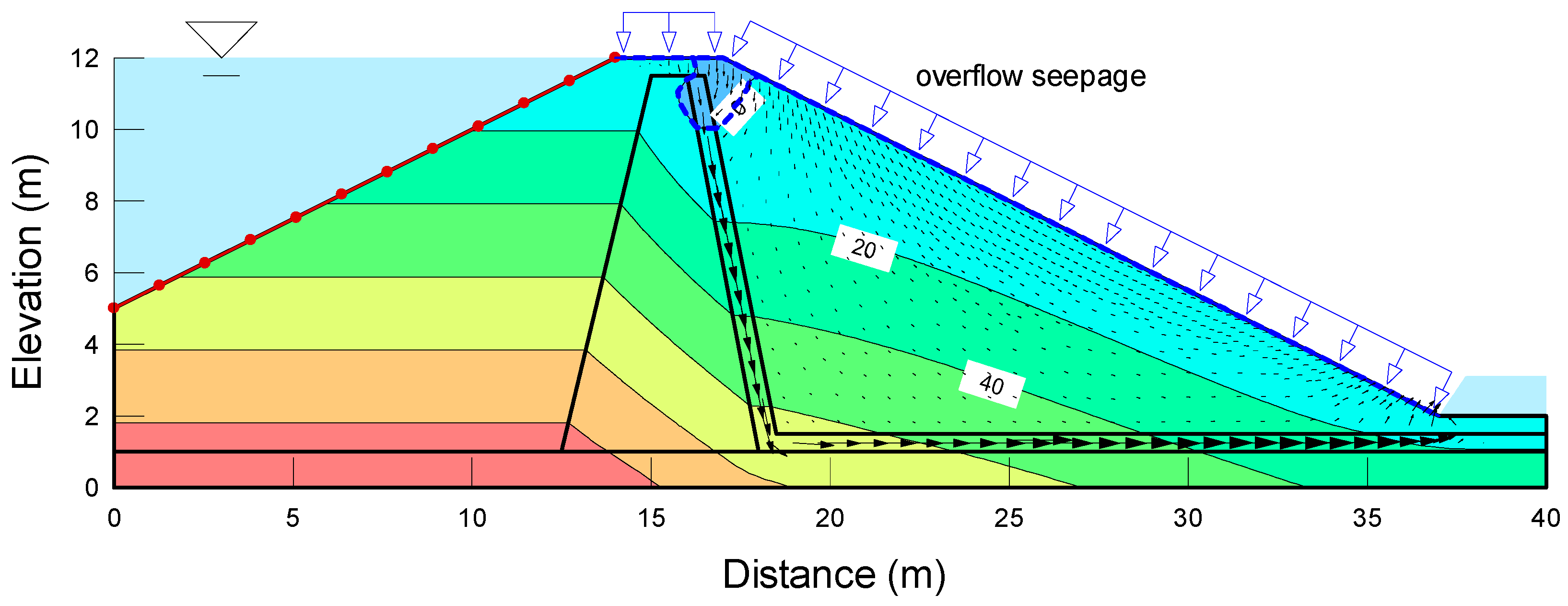

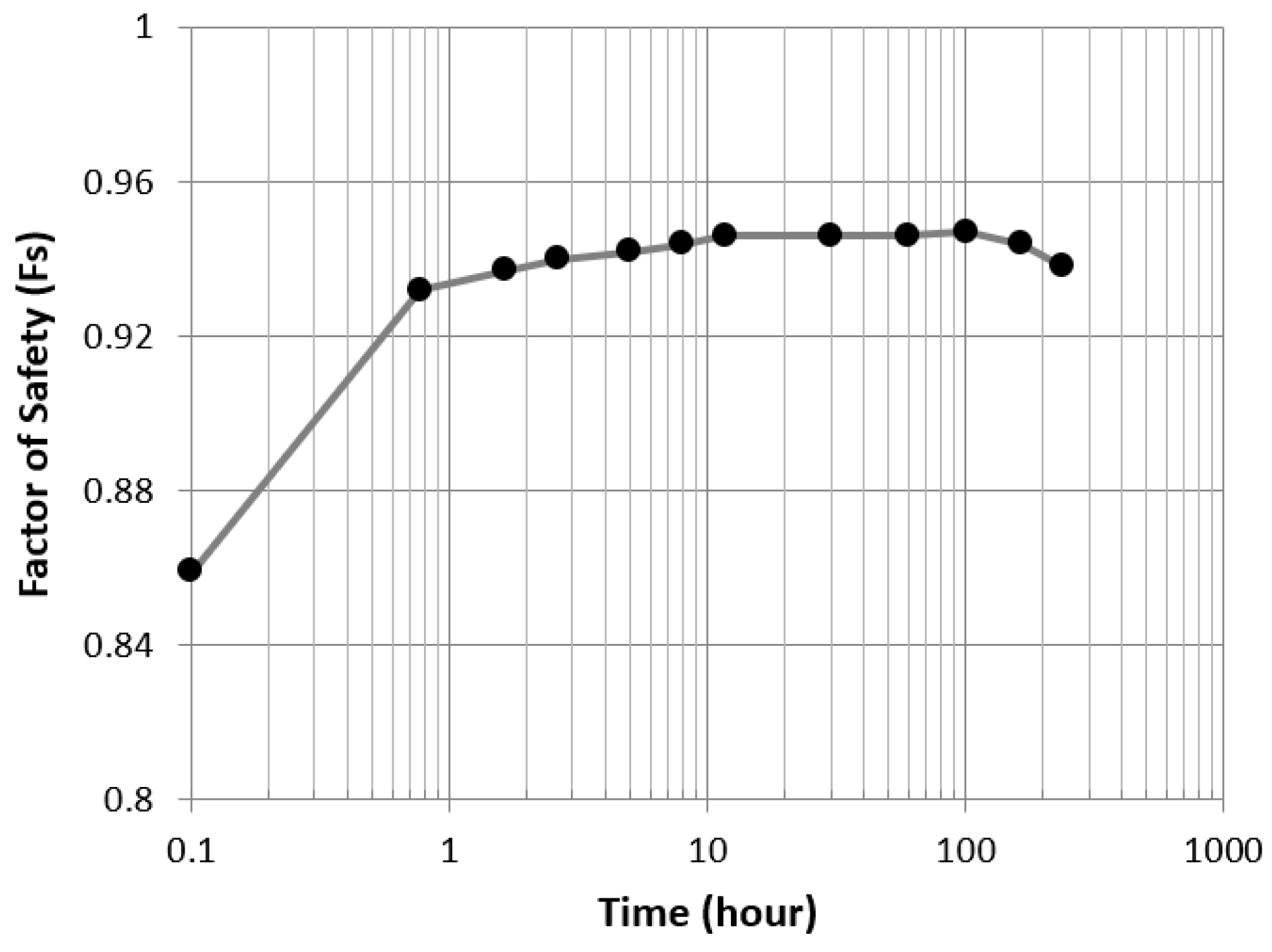
| Causes | Middlebrooks (1953) [7] | Gruner (1967) [8] | Takase (1967) [9] | Babb and Mermel (1968) [10] | Biswas and Chatterjee (1971) [11] | USCOLD (1975) [12] |
|---|---|---|---|---|---|---|
| Overtopping | 30 | 23 | 28 | 36 | 35 | 38 |
| Piping and seepage | 38 | 40 | 44 | 30 | 25 | 44 |
| Foundation defects | 15 | 2 | 10 | 15 | - | 9 |
| Others | 17 | 35 | 18 | 19 | 40 | 9 |
| Name | |
|---|---|
| Gaussian | |
| Gumbel | |
| Student-t |
| Station | Mean (mm) | Stan. Dev. (mm) | Skewness | Kurtosis | Minimum (mm) | Maximum (mm) |
|---|---|---|---|---|---|---|
| 1 | 177.94 | 86.63 | 0.73 | 2.96 | 44.00 | 403.00 |
| 2 | 196.76 | 109.97 | 1.05 | 3.31 | 46.50 | 492.00 |
| 3 | 180.46 | 98.29 | 1.16 | 3.90 | 55.00 | 464.30 |
| 4 | 182.69 | 85.38 | 1.02 | 3.45 | 50.50 | 409.00 |
| 5 | 186.84 | 91.03 | 0.91 | 2.83 | 82.00 | 408.00 |
| 6 | 177.59 | 92.19 | 1.50 | 6.25 | 44.90 | 529.00 |
| 7 | 190.15 | 86.50 | 1.39 | 6.59 | 57.00 | 534.00 |
| 8 | 190.65 | 83.04 | 0.85 | 3.05 | 74.20 | 427.00 |
| 9 | 194.82 | 86.42 | 1.28 | 4.39 | 91.00 | 470.00 |
| 10 | 187.80 | 90.31 | 1.35 | 4.51 | 79.00 | 475.00 |
| 11 | 184.06 | 83.76 | 1.05 | 4.06 | 63.50 | 450.70 |
| 12 | 185.21 | 92.21 | 0.73 | 2.53 | 66.50 | 402.00 |
| Unstable Factors | Condition of Pore-Water Pressure | Factor of Safety |
|---|---|---|
| Regardless of tension cracks | Regardless of pore-water pressure | Above 2.0 |
| With regard to pore-water pressure | Above 1.4 | |
| With regard to tension cracks | Regardless of pore-water pressure | Above 1.8 |
| With regard to pore-water pressure | Above 1.3 |
| Soil Type | Unit Weight (kN/m3) | Cohesion (kN/m2) | Friction Angle (°) | Permeability (m/s) | SWCC Parameters a (kPa), n | Sat./Res. WC (m3/m3) |
|---|---|---|---|---|---|---|
| Fill-up Ground | 19 | 5 | 30 | 5 × 10−6 | 17.54, 3.9 | 0.38/0.01 |
| Clay core | 18 | 15 | 15 | 1 × 10−9 | 50, 2.06 | 0.45/0.08 |
| Drain | 19 | 0 | 32 | 1 × 10−4 | 1.5, 2.1 | 0.3/0.0 |
| Bedrock | - | - | - | Impenetrable | - | - |
Disclaimer/Publisher’s Note: The statements, opinions and data contained in all publications are solely those of the individual author(s) and contributor(s) and not of MDPI and/or the editor(s). MDPI and/or the editor(s) disclaim responsibility for any injury to people or property resulting from any ideas, methods, instructions or products referred to in the content. |
© 2023 by the authors. Licensee MDPI, Basel, Switzerland. This article is an open access article distributed under the terms and conditions of the Creative Commons Attribution (CC BY) license (https://creativecommons.org/licenses/by/4.0/).
Share and Cite
Kim, J.; Kim, Y.; Satyanaga, A. Instability of Embankment Slopes Due to Overflow and Drawdown. Water 2023, 15, 3402. https://doi.org/10.3390/w15193402
Kim J, Kim Y, Satyanaga A. Instability of Embankment Slopes Due to Overflow and Drawdown. Water. 2023; 15(19):3402. https://doi.org/10.3390/w15193402
Chicago/Turabian StyleKim, Jaehong, Yongmin Kim, and Alfrendo Satyanaga. 2023. "Instability of Embankment Slopes Due to Overflow and Drawdown" Water 15, no. 19: 3402. https://doi.org/10.3390/w15193402
APA StyleKim, J., Kim, Y., & Satyanaga, A. (2023). Instability of Embankment Slopes Due to Overflow and Drawdown. Water, 15(19), 3402. https://doi.org/10.3390/w15193402








